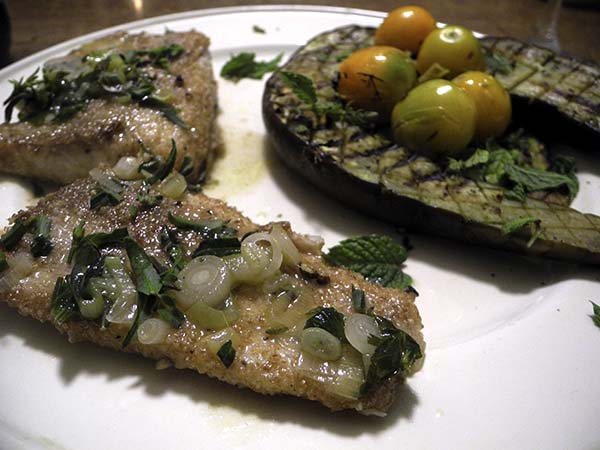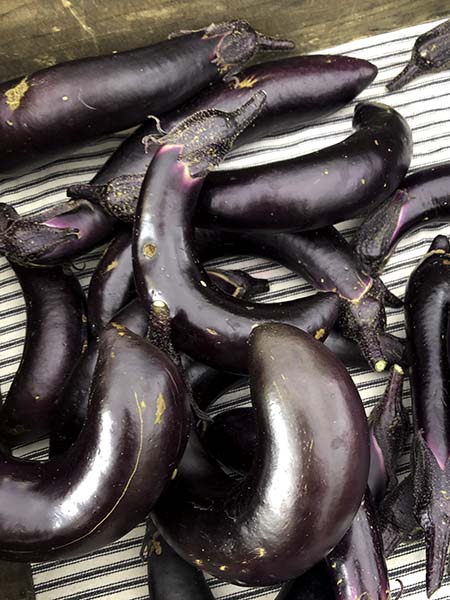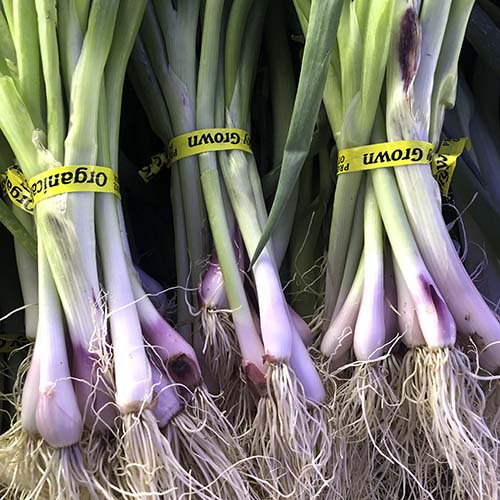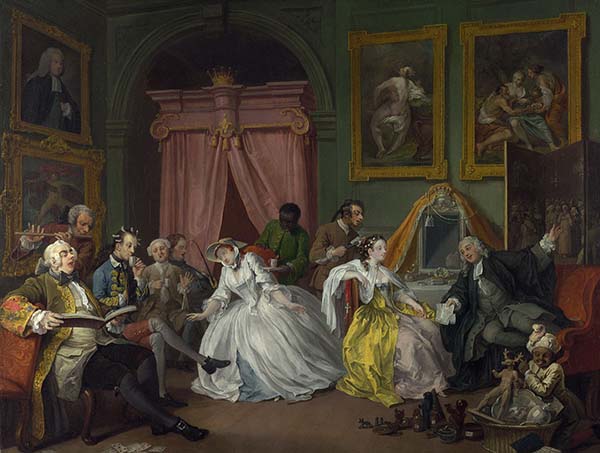
I’m calling it summer shark, even though it was being labelled “sand shark” at the Greenmarket (it’s also called ‘dogfish’, in some places; ‘rock salmon’ in the UK, ‘saumonette’ in France, and ‘palombo’ in Italy), but whatever it’s called, it’s been impossibly delicious each time I’ve prepared it.

This time the vegetable was terrific as well. It was possibly the best grilled Japanese eggplant I’ve ever done, and that’s saying a lot, since it’s my favorite cultivar of all the ‘berries’ of the nightshade family.

Also, just when I had run out of fresh seasoning alliums, some beautiful late-August’ red spring onions’ (they’re actually available much of the season) showed up at the Greenmarket yesterday, helping to ensure the quality of the sauce I would be making for the shark.
- one long ‘summer shark’ fillet weighing one pound from Pura Vida Seafood, brought to room temperature, cut into 4 sections crosswise, dusted with some lightly-seasoned local North Country Farms Stone Ground Whole Wheat Flour, shaking off the excess, sautéed in a little over one tablespoon of olive oil inside a large heavy oval antique copper skillet above a high flame for 4 or 5 minutes on each side, or until browned, the heat then turned off while a second pan, a broad based copper pot, was heated over a low to moderate flame with another tablespoon of oil before 2 fresh finely-chopped red spring onions from Lani’s Farm were added and cooked until softened, stirring occasionally, followed by one medium salted, rinsed, and filleted Sicilian anchovy, more than a tablespoon of chopped Italian parsley from Phillips Farms, and a half cup of wine, an Oregon Pinot Gris, the heat increased and the liquid reduced almost completely before a tablespoon of fresh water was added, the sauce seasoned with a pinch of both local L.I. sea salt and freshly ground black pepper, then poured over the top of the fillet pieces, their skillet heated over a low flame for a minute or two, the fish served on the plates with a sprinkling of pericón (‘Mexican tarragon’) from Norwich Meadows Farm
- three medium Japanese eggplant (12 ounces altogether), from Campo Rosso Farm, each halved lengthwise and scored into a hatch pattern with a very sharp knife, brushed all over with a mixture of a olive oil, 2 finely-chopped ‘Nootka rose’ garlic cloves from TransGenerational Farm, some super-pungent dried Sicilian oregano from Buon Italia, local sea salt and black pepper, pan-grilled inside a large cast iron ribbed pan above 2 brisk flames, turning twice, adding more of the material from the marinade the second time, a few small really delicious ‘honeydrop’ heirloom cherry tomatoes, also from TransGenerational Farm, tossed onto the grill pan just before the eggplant had been removed to the plates and heated, briefly, just enough to warm them through while still retaining their shapes, after which they were arranged strewn on top of their pan mates, both sprinkled with torn spearmint leaves from Stokes Farm and drizzled with a bit more olive oil
- the wine was a Spanish (Rías Baixas/Val do Salnés) white, Albariño “Xión”, Bodegas y Viñedos Attis 2018, from Astor Wines

- the music was a glorious recording of Hugo von Hofmanstahl and RIchard Strauss’ ‘1909-1910 opera (“reactionary luxuriance”*, composed, amazingly, after ‘Salome’ and Elektra’), Der Rosenkavalier’, Herbert von Karajan conducting the Vienna Philharmonic Orchestra, with Agnes Baltsa, Anna Tomowa-Sintow, Kurt Moll, and Janet Perry
*the phrase appears in this 2003 article in the Independent
[the last image, of the Hogarth print that was von Hofmannstahl’s inspiration for the Marschallin’s levée scene in the first act, is from the National Gallery]